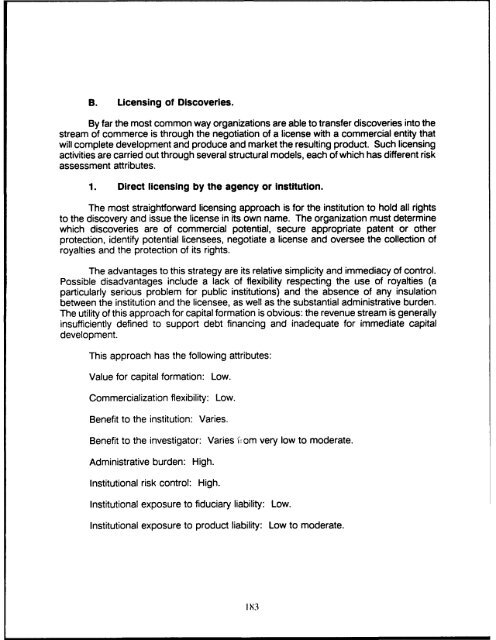Challenges and Opportunities for Innovation in the Public Works ...
Challenges and Opportunities for Innovation in the Public Works ...
Challenges and Opportunities for Innovation in the Public Works ...
You also want an ePaper? Increase the reach of your titles
YUMPU automatically turns print PDFs into web optimized ePapers that Google loves.
B. Licens<strong>in</strong>g of Discoveries.<br />
By far <strong>the</strong> most common way organizations are able to transfer discoveries <strong>in</strong>to <strong>the</strong><br />
stream of commerce is through <strong>the</strong> negotiation of a license with a commercial entity that<br />
will complete development <strong>and</strong> produce <strong>and</strong> market <strong>the</strong> result<strong>in</strong>g product. Such licens<strong>in</strong>g<br />
activities are carried out through several structural models, each of which has different risk<br />
assessment attributes.<br />
1. Direct licens<strong>in</strong>g by <strong>the</strong> agency or <strong>in</strong>stitution.<br />
The most straight<strong>for</strong>ward licens<strong>in</strong>g approach is <strong>for</strong> <strong>the</strong> <strong>in</strong>stitution to hold all rights<br />
to <strong>the</strong> discovery <strong>and</strong> issue <strong>the</strong> license <strong>in</strong> its own name. The organization must determ<strong>in</strong>e<br />
which discoveries are of commercial potential, secure appropriate patent or o<strong>the</strong>r<br />
protection, identify potential licensees, negotiate a license <strong>and</strong> oversee <strong>the</strong> collection of<br />
royalties <strong>and</strong> <strong>the</strong> protection of its rights.<br />
The advantages to this strategy are its relative simplicity <strong>and</strong> immediacy of control.<br />
Possible disadvantages <strong>in</strong>clude a lack of flexibility respect<strong>in</strong>g <strong>the</strong> use of royalties (a<br />
particularly serious problem <strong>for</strong> public <strong>in</strong>stitutions) <strong>and</strong> <strong>the</strong> absence of any <strong>in</strong>sulation<br />
between <strong>the</strong> <strong>in</strong>stitution <strong>and</strong> <strong>the</strong> licensee, as well as <strong>the</strong> substantial adm<strong>in</strong>istrative burden.<br />
The utility of this approach <strong>for</strong> capital <strong>for</strong>mation is obvious: <strong>the</strong> revenue stream is generally<br />
<strong>in</strong>sufficiently def<strong>in</strong>ed to support debt f<strong>in</strong>anc<strong>in</strong>g <strong>and</strong> <strong>in</strong>adequate <strong>for</strong> immediate capital<br />
development.<br />
This approach has <strong>the</strong> follow<strong>in</strong>g attributes:<br />
Value <strong>for</strong> capital <strong>for</strong>mation: Low.<br />
Commercialization flexibility: Low.<br />
Benefit to <strong>the</strong> <strong>in</strong>stitution: Varies.<br />
Benefit to <strong>the</strong> <strong>in</strong>vestigator: Varies i om very low to moderate.<br />
Adm<strong>in</strong>istrative burden: High.<br />
Institutional risk control: High.<br />
Institutional exposure to fiduciary liability: Low.<br />
Institutional exposure to product liability: Low to moderate.<br />
183







